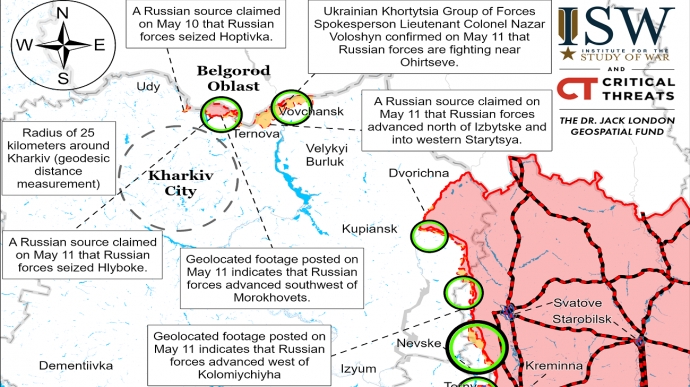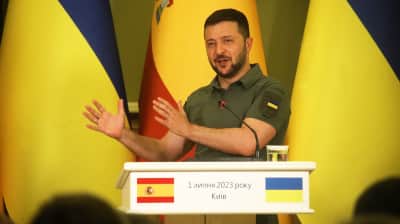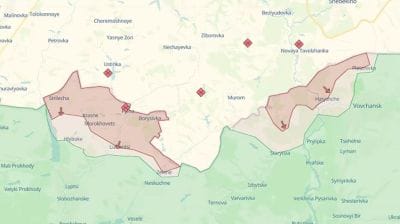Russian offensive in Kharkiv Oblast: ISW analyses Russia's goals

Analysts at the Institute for the Study of War report that the Russians are pursuing several goals with their offensive in Kharkiv Oblast: to draw Ukrainian forces away from other areas, to advance within range of artillery fire on Kharkiv, to create a "buffer zone" to protect Belgorod, and to limit Ukrainian counteroffensive operations in the region.
Source: Institute for the Study of War (ISW)
Details: The ISW's analysis indicates that Russian troops are conducting relatively limited offensive operations along the Russian-Ukrainian border in the north of Kharkiv Oblast and continue to make tactically significant gains in presumably less defensible areas.
However, the analysts point out that the reported number of Russian units involved in these limited operations, as well as the grouping of Russian troops deployed along the border in northeastern Ukraine, indicates that Russian forces are not currently conducting a large-scale operation to surround or capture the city of Kharkiv.
ISW estimates that Russian troops have advanced to at least the outskirts of Ohirtseve and Hatyshche.
Nazar Voloshyn, spokesperson for the Khortytsia Operational Strategic Group, said that Russian troops were trying to advance in areas that were already disputed grey zones, indicating that Ukrainian forces are not holding strong positions in many small border towns.
Russian troops are likely to face more intense resistance as they attempt to advance south of the border and into larger border towns such as Lyptsi and Vovchansk. However, Kharkiv's proximity to the border increases the significance of the limited tactical advantages of Russian forces, as the Russians do not need to advance much further to start threatening Kharkiv with regular shelling.
Russian troops reportedly launched offensive operations along the Russia-Ukraine border in northern Kharkiv Oblast before they had completed bringing the Northern Group of Forces to its planned final strength and have so far deployed only a limited number of combat units to conduct offensive operations in the area.
The ISW reported that Russian offensive operations in the north of Kharkiv Oblast were likely intended to distract Ukrainian forces from other parts of the front, allowing the Russians to advance to the city of Kharkiv within reach of artillery fire.
Russian troops are maintaining the momentum of their offensive operations along the Kupiansk-Svatove-Kreminna line near Chasiv Yar and west of Avdiivka, and the Russian military command is likely hoping that operations in the north of Kharkiv Oblast may force the Ukrainian military command to devote resources to the defence of the north of Kharkiv that it might otherwise have devoted to defending these areas.
Russian ruler Vladimir Putin and the Russian military command may be assessing the risks, prospects and timing of offensive operations in the northern Kharkiv Oblast on the assumption that Ukraine cannot and will not be able to liberate the territories seized by the Russian troops.
The limited nature of Russian offensive operations in the northern part of Kharkiv Oblast suggests that the resumption of US security assistance has not changed Putin's calculations or that he launched the "Kharkiv operation" without reassessing his assumptions about Ukraine's capabilities in light of the resumption of assistance.
In addition, the Russians believe they can make gradual, slow advances across a wide swathe of territory in the north and northeast of Kharkiv Oblast over a long period of time without achieving relatively quick operationally significant gains, but in a way that would disadvantage any future Ukrainian counteroffensive in the region.
"It is imperative for Ukrainian forces to disrupt any such Russian calculations as soon as possible through both limited and large-scale counteroffensive operations that liberate Russian-occupied territory as soon as conditions permit," the analysts say.
ISW has consistently emphasised that Ukrainian troops must seize the offensive initiative as soon as possible.
The direction of Russian offensive operations near the border suggests that Russia may be trying to create a "buffer zone" to protect the city of Belgorod, as recently stated by Russian and Ukrainian officials.
To quote the ISW’s Key Takeaways on 11 May:
- Russian forces are conducting relatively limited offensive operations along the Russian-Ukrainian border in northern Kharkiv Oblast and continued to make tactically significant gains in likely less defended areas. The reported sizes of the Russian elements committed to these limited operations and of the Russian force grouping deployed along the border in northeastern Ukraine indicate that Russian forces are not pursuing a large-scale operation to envelop, encircle, or seize Kharkiv City at this time.
- Russian forces reportedly launched offensive operations along the Russian-Ukrainian border in northern Kharkiv Oblast before they had completed bringing the Northern Grouping of Forces up to its reported planned end strength and have so far only committed a limited amount of combat power to offensive operations in the area.
- ISW continues to assess that the Russian offensive operations in northern Kharkiv Oblast likely aim to draw Ukrainian forces from other sectors of the front while allowing Russian forces to advance to within tube artillery range of Kharkiv City.
- Russian President Vladimir Putin and the Russian military command may be evaluating the risks, prospects, and timeline of offensive operations in northern Kharkiv Oblast based on the assumption that Ukraine cannot and will not be able to liberate territory seized by Russian forces. Putin's and the Russian military command's calculus about the threat of Ukrainian territorial gains is likely shaping Russia's overall operational approach to seizing territory in Ukraine.
- The limited Russian offensive operations in northern Kharkiv Oblast suggest that the resumption of US security assistance has not changed Putin's calculus or that he launched the Kharkiv effort without reassessing the operation's fundamental assumptions about Ukrainian capabilities in light of the resumption of aid.
- The directions of Russian offensive operations in the international border area suggest that Russia may be attempting to create a "buffer zone" to protect Belgorod City, as Russian and Ukrainian officials have recently stated.
- Russian forces appear to be attempting to quickly isolate the battlespace east of the Siverskyi Donets River and seize Vovchansk, a direction of advance that Russian forces may believe could threaten the Ukrainian grouping defending in the Kupiansk direction.
- Donetsk People's Republic (DNR) Head Denis Pushilin reiterated a series of Kremlin narratives intended to justify Russia's invasion of Ukraine and attempted to flatter Russian President Vladimir Putin and the Russian military during an interview in honour of the 10th anniversary of the DNR's founding, likely in an attempt to curry favour in the Kremlin.
- Ukrainian forces reportedly conducted successful drone strikes against a Russian oil refinery in Volgograd Oblast on the night of 10 to 11 May.
- Russian forces recently made confirmed advances in northern Kharkiv Oblast; near Svatove, Chasiv Yar, Avdiivka, and Donetsk City; in western Zaporizhia Oblast; and in east (left) bank Kherson Oblast.
Support UP or become our patron!







